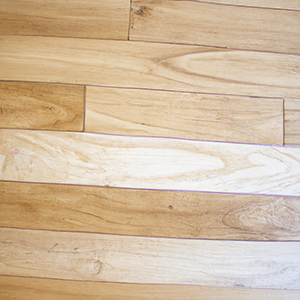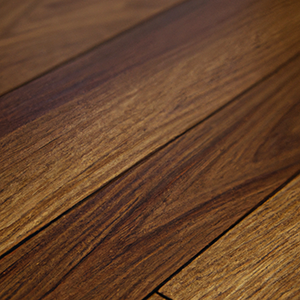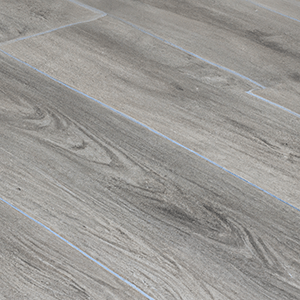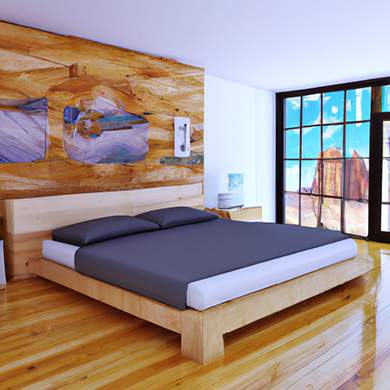Wood floor offers a timeless and natural elegance that can enhance the aesthetics of any interior space. With a wide range of options available, each possessing its own unique characteristics, choosing the right type of wood flooring requires careful consideration.
From the classic charm of solid hardwood to the innovative versatility of engineered wood, there’s a flooring solution for every style, budget, and practical need.
Introduction to the Types of Wood Flooring available
Solid hardwood flooring stands as a symbol of authenticity, showcasing the natural beauty of wood grains, though at a slightly higher cost.
For those seeking durability with a budget-conscious approach, laminate wood flooring replicates the appearance of wood at a fraction of the cost.
Its durability and potential for refinishing make it a long-term investment, though it requires meticulous maintenance to protect against moisture. Engineered wood flooring, on the other hand, offers enhanced stability through layers of wood veneers, making it suitable for areas with fluctuating humidity levels.
Bamboo flooring is often promoted as an eco-friendly alternative, while cork flooring.
Choosing reclaimed wood flooring adds character by repurposing old wood into new flooring, while exotic wood species can infuse spaces with distinct patterns and colours.
This article will explore the pros and cons of each while giving you an idea of the costs involved when buying each one.
Hopefully, guiding you towards an informed decision that aligns with your preferences and lifestyle.
So, let’s dive in.
1. Solid Hardwood Flooring

Solid wood flooring, also known as hardwood flooring, is a type of flooring material made entirely from real wood. It’s constructed from solid pieces of lumber, usually cut from a single piece of timber.
Each plank of solid wood flooring is made from the same type of wood, providing a consistent appearance and durability throughout. That said, Solid wood planks can exhibit natural variations in colour, grain pattern, and texture, adding to the uniqueness and charm of each piece.
Price:
Ranging from £50+ per m2 (not cheap)
Lifespan/Durability
50 years or more
Pros
- Offers the authentic and natural look
- Classic and timeless appearance.
- Can be sanded and refinished multiple times.
- is durable and can withstand heavy foot traffic
- Better as a long term investment
Cons
- Susceptible to moisture and temperature changes.
- Higher upfront cost compared to some alternatives.
Subfloor Preparation
Ensure the subfloor is clean, dry, level, and free of debris. Any unevenness can lead to problems with the hardwood installation.
Underlayment:
Underlayment is typically not used with solid hardwood flooring. Instead, a moisture barrier may be necessary in areas with potential moisture issues.
2. Engineered Wood Flooring
 Engineered wood flooring is a type of flooring that is constructed from multiple layers of wood to provide enhanced stability and versatility compared to solid hardwood flooring.
Engineered wood flooring is a type of flooring that is constructed from multiple layers of wood to provide enhanced stability and versatility compared to solid hardwood flooring.
It combines the natural beauty of real wood with the practical benefits of modern engineering.
The cross-layered construction of the core layers minimises the natural expansion and contraction that wood experiences due to changes in humidity and temperature.
So, if your home experiences varying humidity levels (and most of us do in the UK), then this would a better choice than solid wood.
Price
£30 to £90 per m2 (cheaper than solid wood)
Lifespan/Durability
20-30 years
Pros
-
-
- More stable in varying humidity conditions. Better than solid wood flooring
- Wide range of wood species and finishes available.
- Less prone to warping, cupping, and gaps, making it suitable for areas with fluctuating moisture levels
- can be installed on various types of subfloors, including concrete
-
Cons
-
-
- Limited refinishing options compared to solid hardwood.
- Top layer can still be susceptible to scratching and wear. Some say to avoid wearing high heels on it.
-
Subfloor Preparation
The subfloor should be clean, dry, level, and structurally sound. Engineered wood can be more forgiving of minor subfloor irregularities.
Underlayment
Depending on the manufacturer’s recommendations, an underlayment may be required to provide moisture protection, sound insulation, or a cushioning effect. It can also increase warmth if you choose a higher tog product Some engineered wood floors come with attached underlayment.
3. Laminate Wood Flooring
 The number one benefit of laminate Wood flooring is the affordability.
The number one benefit of laminate Wood flooring is the affordability.
It’s a synthetic flooring material designed to mimic the appearance of real hardwood while offering durability, affordability, and easy maintenance. It’s composed of several layers that are fused together through a lamination process.
It’s generally made up of 4 layers – Wear, Decorative, Core & backing from top to bottom respectively
The top layer is a clear, protective wear layer made of melamine or aluminium oxide to resist scratches, stains, and fading. This is the layer that will vary the most – normally by thickens and quality – as the price increases.
Beneath the wear layer is a high-resolution printed image layer that mimics the look of wood, stone, or other natural materials. This layer gives the flooring its realistic appearance.
The core layer provides stability on strength while the bottom/backing layer acts a moisture barrier
Price
From £15 per m2 (Budget Option)
Durability/Longevity
10-20 years
Pros
-
-
- Highly durable and resistant to scratches and dents.
- Budget-friendly option that can mimic the appearance of hardwood.
- Huge range to match many décor styles and tastes
- Low maintenance
-
Cons
-
-
- Not actual wood, which may affect authenticity.
- Limited refinishing potential.
- Scratches easily
-
Subfloor Preparation
Ensure the subfloor is clean, dry, level, and free of any bumps or imperfections that could transfer to the laminate surface.
Underlayment
An underlayment is usually recommended for laminate flooring. It can provide sound absorption, moisture protection, and a smoother surface for the laminate planks to rest on.
4. Bamboo Flooring
Bamboo flooring is often promoted as an eco-friendly alternative. Not only known for it’s strength but also it’s rapid renewability. Meaning harvesting of bamboo doesn’t deplete its overall population because it grows so quickly.
Price
£25 – £60 per m2
Lifespan/Durability
20-30 years
Pros
-
-
- Rapidly renewable resource, eco-friendly option.
- Hard and durable material.
-
Cons:
-
-
- Prone to scratches and dents.
- Quality can vary significantly among manufacturers.
-
Subfloor Preparation
Follow similar subfloor preparation steps as for solid hardwood or engineered wood flooring.
Underlayment
Depending on the bamboo flooring product and the manufacturer’s recommendations, underlayment may be needed to provide cushioning, insulation, and moisture protection.
5. Cork Flooring
Cork flooring is a unique and eco-friendly type of flooring made from the bark of cork oak trees (Quercus suber). It’s known for its distinctive appearance, comfort underfoot, and various benefits.
The bark is carefully harvested every 9-12 years without harming the trees, making cork a renewable and sustainable resource.
Cork boards are generally installed by 2 different methods – glue down or click-lock.
Price
from around £20 to £50 per square meter (m2)
Lifespan/Durability
20-30 years
Pros
-
-
- Soft and comfortable underfoot.
- Natural acoustic and thermal insulator.
-
Cons
-
-
- Susceptible to moisture damage if not properly sealed.
- Can show signs of wear over time.
-
A few things to think about
Adding value to your home
The more you spend on your floor, then more likely it is to add value to your home.
That said, if you’re using a cheaper laminate to spruce up your home for a sale, it can significantly improve the look and feel of any room. Remember too that value is determined by the buyer, so you might want to think a bit more about current trends when opting to do it for a quicker sale.
Maintenance and Durability
Proper care and maintenance is required for any wood product that you install. That is if you want your new investment to last. Simple things like regular cleaning, avoiding spills and using furniture pads will all aid the longevity of your wood floor




